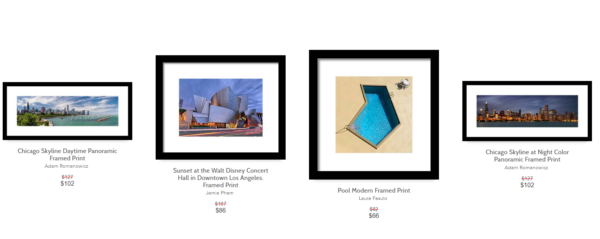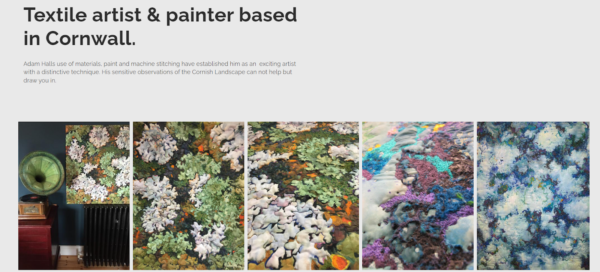
You probably became an artist to share your vision and creativity with the world. Most artists are driven by a passion to create beautiful things using their desired medium. However, this industry can be tough to break into, which intimidates a lot of budding artists from even trying. But selling your art online is an easy way to connect to customers and make sales. One of the most successful ecommerce platforms for artists is Etsy, which had a revenue of $1.7 billion in 2020.
Learning how to sell your art online can help you turn a hobby into a thriving business.
We make it easy to get your work out to your network and beyond with all the marketing tools you need.
Where to sell artwork online
Etsy is the best platform for selling artwork online, with 39.4 million customers in 2020. As an artist, you benefit from the site’s name recognition, and the platform is easy to use. You can also use other online platforms, including your own website, to broaden your reach.
Etsy
Etsy is one of the largest global online retailers, with almost 4.4 million sellers in 2020. The platform is very user-friendly. If you’re just starting out with little name recognition, Etsy is a good spot for learning the ins and outs when you sell your art online.
Your art will be easy to find, and you can learn the logistics behind your business, including taxes and shipping, pricing, and customer service. Etsy’s large artist database gives you access to competitive analysis. If your products aren’t moving, you can peruse the site to compare designs, prices, and more.
Amazon
Amazon lets small, independent business owners and artists sell their work through its platform. As the top ecommerce shop in the world, Amazon is the place to go if you’re looking for exposure. However, there are some drawbacks to selling art through the site. It has rules and restrictions on fine art listings. You may be asked to lower your prices if the site thinks they’re too high.
But Amazon helps bring your art to millions of people. If you’re building your brand, listing your art on Amazon helps you get noticed by customers who might not have found you on Etsy or through a local art market.
Fine Art America
If you would rather be listed on an exclusive website, try Fine Art America. This website specializes in connecting art buyers to artists. Its crisp, clean layout brings the gallery experience online. Buyers can easily filter art by medium and category.

ArtPal
Like Fine Art America, ArtPal is a specialty ecommerce site for artists specializing in a variety of media. You can sell anything from paintings to glass through this website, with about 200,000 sellers.
Since it’s smaller, you won’t have as much competition on this site. It’s a good place to go if you want to stand out or sell to people who appreciate art but prefer buying in a way that’s more accessible than a gallery. ArtPal is a free gallery, and it doesn’t charge membership fees or take commissions on your sales.
VSUAL
VSUAL is another great free resource if you’re starting out. This site makes it easy to upload and sell prints of your art, and it handles the logistics for you. Since VSUAL sells reprints of original work, use it to sell your best pieces to multiple customers without having to create a new piece every time or print it yourself.
Every seller on the platform has access to VSUAL’s customer service team. Memberships on the site are very reasonable.
How to sell your art online
Once you’ve decided which site to use, it’s time to sell your work online. You can use just one of these websites or create multiple accounts. Using more than one platform lets you broaden your reach, allowing people to find you in more places regardless of where they shop for art online.
Identify your niche and objectives
Finding your niche will help you decide what kinds of customers to target. You can try to appeal to the masses, but most artists prefer to work with a particular medium, style, and subject matter.
To choose your niche, consider these factors:
Look at your previous works and figure out where they fit in. Do you lean toward expressionism? Do you prefer making portraits that resemble photographs? Are you a landscape photographer? Your chosen style and medium will help you when writing your artist bio and branding your work. It will also help you figure out which tags to add to your product descriptions so fans can find you.
When you know your preferred style and medium, figure out your purpose. Are you more interested in creating fine art for collectors, or would you like to create functional work that can be displayed in a more commercial setting?
You don’t have to stick with your preferred niche, and your work might fit into more than one. But it’s important to narrow your focus so you can brand and sell your art online.
Do market research
Like any other business owner, you will have competitors. Although selling artwork online significantly widens your customer base, you should still do some competitive analysis and create buyer profiles to improve your chances of successfully reaching customers who like your work.
Knowing your customers’ personalities, demographics, and preferences will help you market your work to them. Having an idea of your main competitors lets you define how your work is unique. Differentiate yourself from your competition by highlighting what you offer that your competition doesn’t. To research your market:
- Look through your social media followers for similar characteristics.
- Compare the demographics of your previous customers.
- Use these demographics and interests to tailor your social media posts.
- Compare your work with other artists in your niche.
- Look for differences you can highlight to stand out.
- Consider your target market’s preferences and demographics when pricing your work.
Create value for your customers
Clearly defining how you add value for your customer is one of the most effective marketing strategies. As an artist, you might not naturally think like a business owner, and figuring out how you benefit your customers can be tricky. Start by asking current customers to review your work and using their answers to determine your value.
Your art will add value to your clients based on their wants and needs. A person who commissions a memorial portrait of a beloved pet sees value in the comfort provided by it. A commercial client who hangs your intricate paintings in their lobby sees the value in elevating their atmosphere with unique, handmade art.
Knowing what you do best and what your current and past customers appreciate most about your work will help you more successfully build your brand.
Set up your portfolio and online profiles
A strong portfolio makes it easier to sell your work online. Set up a portfolio website you can link to each of your online profiles. Post this link on your chosen ecommerce platforms and put it in your social media bios. Guidelines for setting up your website include:
- Make the site easy to navigate
- Design a site that is responsive on mobile devices
- Don’t hide your contact information
- Proofread all your copy for typos (or have a friend do it)
- Update it regularly
Use social media platforms including Instagram, Pinterest, DeviantArt, and Facebook to promote your work. Post regularly to improve your following and jump on appropriate hashtags to widen your net.
In your portfolio, choose your best work and only use high-resolution photos. Since you’re using your portfolio to sell your art online, pick pieces that represent the types of work you are interested in selling. If your chosen niche is handmade glass ornaments but you had to make some sculptures for school, focus on the ornaments.
You can include multiple types of work in your online portfolio but organize your gallery in a logical way. Group pieces together that make sense. Use your grid to tell a story and communicate your personality to potential buyers.
On his homepage, painter and textile artist Adam Halls includes photos of his work from multiple angles, mixing his textile work with his paintings.

Best marketing practices for selling your art online
When you’re happy with your online shop and portfolio, you can start building your brand. Creating a solid online presence will help people learn about you and your work. Gaining a reputation for quality, unique work helps generate more interest and increase your sales.
Use social media to add value
Since you make all of your art, your online followers can’t see it anywhere else. This type of unique content is known as value-added content. Share photos of completed work, behind-the-scenes videos and livestreams of you making art, and other posts that draw in interested viewers.
Value-added content helps you stand out from your competitors because it shows your viewers what makes you different.
Take advantage of sponsored posts
Paying to run ads on social media, including Facebook and Instagram, places your profile in front of people who might be interested. Your market research will come in handy since Facebook and Instagram give you the option to select a target audience based on their interests and/or demographics.
When creating a sponsored post, start small. Run the same ad to different target test audiences to see which one generates more traffic. Or target the same users with ads that are slightly different. Switch up your layout or your copy and run the two test ads against each other to see which encourages more people to click.
After you have an idea of your target audience and the best ads for your artwork, run sponsored posts that include a call to action to visitors. Use action words like “shop now” or “visit our online shop.” Make your work exclusive by including phrases like “limited stock” or “one of a kind.”
Run retargeting ads
Facebook ads also offer a feature to run sponsored posts to people who visit your site and then leave. The platform lets you add a pixel to your website, which is a string of code that tracks how people are interacting with it.
When someone looks through your online shop and leaves without buying anything, it triggers an automated Facebook ad within a defined time frame. Create a generic ad for people who have left your website. Or make more than one that can run based on how people interacted with your site.
For example, you can create an abandoned cart ad for people who’ve added merchandise to their cart before leaving your website. The ad would include copy like, “Forgot something?” to entice them back to your site to finish the purchase.
People who looked through your site without adding anything to their carts would receive a different ad encouraging them to return.
Where to start
Learning how to sell art online greatly improves your potential customer base. You no longer have to wait to show in a gallery for name recognition. To start the process, identify your niche and desired ecommerce goals.
Then build an online portfolio highlighting your best work. Configure your photo grid so it’s interesting and appealing to potential buyers. Next, do some market research and start cultivating your social media following with value-added posts that appeal to your target demographics.
Soon, you’ll have a following and you’ll be selling your art online in no time.




